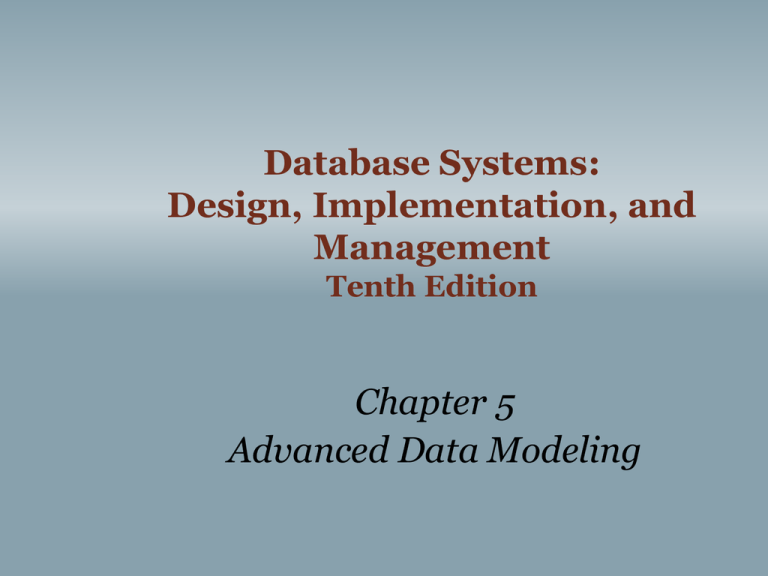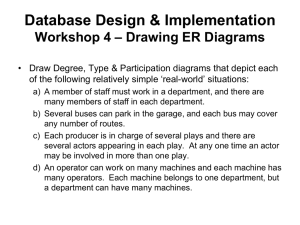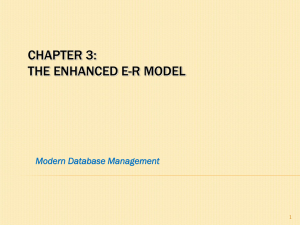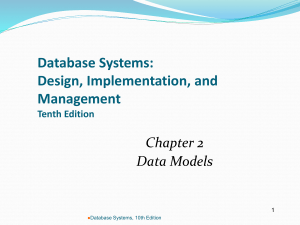Ch05
advertisement

Database Systems: Design, Implementation, and Management Tenth Edition Chapter 5 Advanced Data Modeling Entity Supertypes and Subtypes 2 Entity supertype Generic entity type related to one or more entity subtypes Contains common characteristics Entity subtype Contains unique characteristics of each entity subtype Database Systems, 10th Edition 3 Database Systems, 10th Edition Specialization Hierarchy 4 Depicts arrangement of higher-level entity supertypes and lower-level entity subtypes Relationships described in terms of “IS-A” relationships Subtype exists only within context of supertype Every subtype has only one supertype to which it is directly related Can have many levels of supertype/subtype relationships Database Systems, 10th Edition 5 Database Systems, 10th Edition Inheritance 6 Enables entity subtype to inherit attributes and relationships of supertype All entity subtypes inherit their primary key attribute from their supertype At implementation level, supertype and its subtype(s) maintain a 1:1 relationship Entity subtypes inherit all relationships in which supertype entity participates Lower-level subtypes inherit all attributes and relationships from all upper-level supertypes Database Systems, 10th Edition 7 Database Systems, 10th Edition Subtype Discriminator 8 Attribute in supertype entity Determines to which entity subtype each supertype occurrence is related Default comparison condition for subtype discriminator attribute is equality comparison Subtype discriminator may be based on other comparison condition Database Systems, 10th Edition Disjoint and Overlapping Constraints 9 Disjoint subtypes Also called nonoverlapping subtypes Subtypes that contain unique subset of supertype entity set Overlapping subtypes Subtypes that contain nonunique subsets of supertype entity set Database Systems, 10th Edition 10 Database Systems, 10th Edition Completeness Constraint 11 Specifies whether entity supertype occurrence must be a member of at least one subtype Partial completeness Symbolized by a circle over a single line Some supertype occurrences are not members of any subtype Total completeness Symbolized by a circle over a double line Every supertype occurrence must be member of at least one subtype Database Systems, 10th Edition 12 Database Systems, 10th Edition Specialization and Generalization 13 Specialization Identifies more specific entity subtypes from higher-level entity supertype Top-down process Based on grouping unique characteristics and relationships of the subtypes Database Systems, 10th Edition Specialization and Generalization (cont’d.) 14 Generalization Identifies more generic entity supertype from lower-level entity subtypes Bottom-up process Based on grouping common characteristics and relationships of the subtypes Database Systems, 10th Edition Entity Clustering 15 “Virtual” entity type used to represent multiple entities and relationships in ERD Considered “virtual” or “abstract” because it is not actually an entity in final ERD Temporary entity used to represent multiple entities and relationships Eliminate undesirable consequences Avoid display of attributes when entity clusters are used Database Systems, 10th Edition 16 Database Systems, 10th Edition Entity Integrity: Selecting Primary Keys 17 Primary key is the most important characteristic of an entity Single attribute or some combination of attributes Primary key’s function is to guarantee entity integrity Primary keys and foreign keys work together to implement relationships Properly selecting primary key has direct bearing on efficiency and effectiveness Database Systems, 10th Edition Natural Keys and Primary Keys 18 Natural key is a real-world identifier used to uniquely identify real-world objects Familiar to end users and forms part of their day-to-day business vocabulary Generally, data modeler uses natural identifier as primary key of entity being modeled May instead use composite primary key or surrogate key Database Systems, 10th Edition Primary Key Guidelines 19 Attribute that uniquely identifies entity instances in an entity set Could also be combination of attributes Main function is to uniquely identify an entity instance or row within a table Guarantee entity integrity, not to “describe” the entity Primary keys and foreign keys implement relationships among entities Behind the scenes, hidden from user Database Systems, 10th Edition 20 Database Systems, 10th Edition When to Use Composite Primary Keys 21 Composite primary keys useful in two cases: As identifiers of composite entities In which each primary key combination is allowed once in M:N relationship As identifiers of weak entities In which weak entity has a strong identifying relationship with the parent entity Automatically provides benefit of ensuring that there cannot be duplicate values Database Systems, 10th Edition When to Use Composite Primary Keys (cont’d.) 22 When used as identifiers of weak entities normally used to represent: Real-world object that is existent-dependent on another realworld object Real-world object that is represented in data model as two separate entities in strong identifying relationship Dependent entity exists only when it is related to parent entity Database Systems, 10th Edition When To Use Surrogate Primary Keys 23 Especially helpful when there is: No natural key Selected candidate key has embedded semantic contents Selected candidate key is too long or cumbersome Database Systems, 10th Edition When To Use Surrogate Primary Keys (cont’d.) 24 If you use surrogate key: Ensure that candidate key of entity in question performs properly Use “unique index” and “not null” constraints Database Systems, 10th Edition 25 Database Systems, 10th Edition Design Cases: Learning Flexible Database Design 26 Data modeling and design requires skills acquired through experience Experience acquired through practice Four special design cases that highlight: Importance of flexible design Proper identification of primary keys Placement of foreign keys Database Systems, 10th Edition Design Case 1: Implementing 1:1 Relationships 27 Foreign keys work with primary keys to properly implement relationships in relational model Put primary key of the “one” side on the “many” side as foreign key Primary key: parent entity Foreign key: dependent entity Database Systems, 10th Edition Design Case 1: Implementing 1:1 Relationships (cont’d.) 28 In 1:1 relationship, there are two options: Place a foreign key in both entities (not recommended) Place a foreign key in one of the entities Primary key of one of the two entities appears as foreign key of other Database Systems, 10th Edition 29 Database Systems, 10th Edition 30 Database Systems, 10th Edition Design Case 2: Maintaining History of Time-Variant Data 31 Normally, existing attribute values are replaced with new value without regard to previous value Time-variant data: Values change over time Must keep a history of data changes Keeping history of time-variant data equivalent to having a multivalued attribute in your entity Must create new entity in 1:M relationships with original entity New entity contains new value, date of change Database Systems, 10th Edition 32 Database Systems, 10th Edition 33 Database Systems, 10th Edition Design Case 3: Fan Traps 34 Design trap occurs when relationship is improperly or incompletely identified Represented in a way not consistent with the real world Most common design trap is known as fan trap Fan trap occurs when one entity is in two 1:M relationships to other entities Produces an association among other entities not expressed in the model Database Systems, 10th Edition 35 Database Systems, 10th Edition Database Systems, 10th Edition 36 Design Case 4: Redundant Relationships 37 Redundancy is seldom a good thing in database environment Occurs when there are multiple relationship paths between related entities Main concern is that redundant relationships remain consistent across model Some designs use redundant relationships to simplify the design Database Systems, 10th Edition 38 Database Systems, 10th Edition








